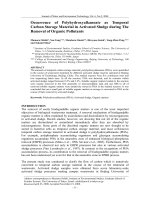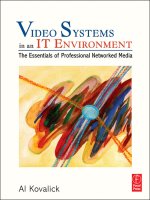Video Systems in an IT Environment The Essentials of Professional Networked Media potx
Bạn đang xem bản rút gọn của tài liệu. Xem và tải ngay bản đầy đủ của tài liệu tại đây (10.42 MB, 599 trang )
Video Systems
in an IT Environment
The Essentials of Professional Networked Media
K80627-Prelims 11/18/05 4:16 PM Page i
K80627-Prelims 11/18/05 4:16 PM Page ii
Video Systems
in an IT Environment
The Essentials of Professional
Networked Media
Author
Al Kovalick
AMSTERDAM • BOSTON • HEIDELBERG • LONDON
NEW YORK • OXFORD • PARIS • SAN DIEGO
SAN FRANCISCO • SINGAPORE • SYDNEY • TOKYO
Focal Press is an imprint of Elsevier
K80627-Prelims 11/18/05 4:16 PM Page iii
Acquisitions Editor: Angelina Ward
Project Manager: Carl M. Soares
Assistant Editor: Rachel Epstein
Design Manager: Cate Barr
Interior Design: Integra Software Services Pvt, Ltd
Focal Press is an imprint of Elsevier
30 Corporate Drive, Suite 400, Burlington, MA 01803, USA
Lincare House, Jordan Hill, Oxford OX2 8DP, UK
Copyright © 2006, Elsevier Inc. All rights reserved.
No part of this publication may be reproduced, stored in a retrieval system, or transmitted in
any form or by any means, electronic or mechanical, photocopying, recording, or otherwise,
without the prior written permission of the publisher.
Permissions may be sought directly from Elsevier’s Science & Technology Rights
Department in Oxford, UK: phone: (ϩ44) 1865 843830, fax: (ϩ44) 1865 853333,
E-mail: You may also complete your request on-line
via the Elsevier homepage (), by selecting “Support & Contact”
then “Copyright and Permission” and then “Obtaining Permissions.”
Recognizing the importance of preserving what has been written, Elsevier prints its books on
acid-free paper whenever possible.
Library of Congress Cataloging-in-Publication Data
Application Submitted
British Library Cataloguing-in-Publication Data
A catalogue record for this book is available from the British Library.
ISBN 13: 978-0-240-80627-3
ISBN 10: 0-240-80627-1
For all information on all Elsevier Focal Press publications
visit our Web site at www.books.elsevier.com
Printed in the United States of America
050607080910 10987654321
Working together to grow
libraries in developing countries
www.elsevier.com | www.bookaid.org | www.sabre.org
K80627-Prelims 11/18/05 4:16 PM Page iv
Contents
Acknowledgments vii
Introduction ix
1 Networked Media in an IT Environment 1
2 The Basics of Professional Networked Media 37
3A Storage System Basics 95
3B Storage Access Methods 143
4 Software Technology for AV Systems 187
5 Reliability and Scalability Methods 227
6 Networking Basics for AV 269
K80627-Prelims 11/18/05 4:16 PM Page v
7 Media Systems Integration 315
8 Security for Networked AV Systems 367
9 Systems Management and Monitoring 401
10 The Transition to IT: Issues and Case Studies 437
11 A Review of AV Basics 469
Appendix A Fast Shortcuts for Computing 2
N
513
Appendix B Achieving Frame Accuracy in a Non-frame Accurate World 515
Appendix C Grid, Cluster, Utility, and Symmetric
Multiprocessing Computing 517
Appendix D How Much Information Exists? 523
Appendix E 8B/10B Line Coding 525
Appendix F Digital Hierarchies 527
Appendix G 270 Million—A Magic Number in Digital Video 531
Appendix H A Novel AV Storage System 533
Appendix I Is It Rabbits Multiplying or Is It Streaming? 537
Appendix J How to Evaluate a Video Server 539
Appendix K Blade Servers 545
A Glossary of AV/IT Terms 549
Index 565
Contents
vi
K80627-Prelims 11/18/05 4:16 PM Page vi
Acknowledgments
This book would never have seen the light of day if it were not for
many friends and colleagues who assisted me along the way. Some helped
as technical reviewers, some as consultants, some as encouraging
voices, and all as solid supporters. I am grateful to all of you. Thanks go to
Frans De Jong, Santosh Doss, Brad Gilmer, Jacob Gsoedl, Mark Johnston,
Greg Lowitz, Bill Moren, Harlan Neugeboren, Charles Poynton,
Michel Proulx, John Schmitz, and Joanne Tracy.
This book is dedicated to my parents, Al and Virginia, and to my lov-
ing wife May, who provided constant support and encouragement during
the entire project.
K80627-Prelims 11/18/05 4:16 PM Page vii
K80627-Prelims 11/18/05 4:16 PM Page viii
Introduction
There is a tide in the affairs of men,
which, taken at the flood, leads on to fortune;
omitted, all the voyage of their life
is bound in shallows and in miseries
—William Shakespeare
Astute sailors know the optimal time to catch the tidal flood toward
the harbor. If missed, a ship may be caught in a storm or stranded at sea.
An able captain and crew never pass up favorable currents. Today there
is a different tidal flood that many captains of ship are seeking to ride to
safe harbor. What is it? It is the tidal swell of information technology
(IT)
1
that is being leveraged to create compelling video systems
2
and AV
workflows for broadcasters and other professional operations. In the big
picture, we are at the emergent stages of video systems designed from
hybrid combinations of IT standard platforms (storage, servers, routers,
networks, firewalls, middleware, software platforms, Internet, Web ser-
vices, archives, etc.) and traditional AV methods and technology.
If you are only conversant in IT methods or only comfortable with
traditional video techniques, then the hybrid combination may seem a bit
1
The “IT” term is used throughout this book to refer to the standard platforms, systems, and
methods that comprise information technology as used by business processes worldwide.
2
In this book the term “video systems” includes audio systems and still graphics. As a composite,
they are denoted by the term “AV” or “A/V” systems. The hybrid acronym AV/IT describes systems
that use a combination of IT and traditional AV technologies.
K80627-Prelims 11/18/05 4:16 PM Page ix
strange and worrying. Will IT methods, systems, and techniques be respon-
sive enough for the demands of real-time video? Can IT meet a 99.9999%
reliability goal? Can I run video over and through IT-based links and
switches? Will network congestion cause dropouts in my video? Will a virus
or worm take me off air? Can I upgrade my system while it is in use? Will the
short life spans of IT equipment lead to an unprofitable ROI and constant
retooling headaches? Is using IT too risky for my demanding operations?
Are the software components stable enough for mission critical applications?
Can I use IT ϩ AV technologies and create a “Broadcast IT” system? These
and countless other concerns are discussed and resolved in this book. First,
let us look a bit deeper at the interesting cross section of IT plus AV.
Figure Intro.1 depicts the two domains of interest to us and their all
important overlap. As the workflows, methods, and technology of the IT
world and those of traditional video mix and combine, compelling new
formulations emerge. The IT sphere consists of domain experts plus all
the standard infrastructure and systems that make up IT. However, the
traditional time-based media sphere consists of domain experts, video-
specific links and routers, VTRs, cameras, A/V editors, on-air graphics,
effects processors, vision mixers, and much more. The overlap region
Introduction
x
IT Systems,
Methods & Technologies
Video Systems,
Methods & Technologies
Joint Systems Domain
– using concepts from
both regions
FIGURE
INTRO.1
The joint systems domain of hybrid AV/IT systems.
K80627-Prelims 11/18/05 4:16 PM Page x
gathers selected components together from each domain, thereby creat-
ing IT-based media workflows.
Which domain has a greater gravitational pull on the other? In 2004,
IT equipment and services was nearly a $1 trillion WW market (source:
IDC) while the entire broadcast equipment market was $12.4 billion
(source: DIS Consulting 2004). This is about a 100:1 ratio, and the smaller
of the two is drawn to the larger to take advantage of the many levers that
IT can provide for video system design. The arrows imply the gradual slid-
ing on the AV domain onto the IT domain. Many of the biggest broad-
casters have already embraced IT and have large deployments (see
Chapter 10), whereas others are still waiting to put their toe into the water.
It is the compelling mix of IT ϩ AV that is our focus. Our approach is
judiciously biased toward the understanding of how AV systems can leverage
IT techniques and tools. The chapters that follow cover IT in relation to the
workflow needs of video systems. The intention is not to fully describe
media technology but rather to explain IT in the light of video systems.
Figure Intro.2 illustrates a traditional AV system on the left and a
hybrid AV ϩ IT system on the right. Traditional is composed of custom
AV components, specialized software, and exotic technologies—usually
Introduction
xi
Migration
A / V Applications and Workflows
Middleware
IT Platforms
(storage, servers,
Internet, LAN, WAN,
software platforms,
web services, security,
element management,
…)
A / V specific
HW and SW
A / V Applications and Workflows
A
/ V
Specific
HW
A / V
Specific
HW
A / V
Specific
HW
A
/ V
A / V
Traditional A
/ V System
Hybrid IT + A
/ V System
FIGURE
INTRO.2
The move to IT reduces the amount of custom A/V gear.
K80627-Prelims 11/18/05 4:16 PM Page xi
in small volumes. However, the hybrid mix leverages standard products
from information technology and adds AV-specific elements only as
needed by the workflow requirements. Some modern hybrid systems are
90% IT and 10% AV in terms of technology. Just a few years ago, the fab-
ric of a typical AV system was 90% AV specific with just a pinch of IT. The
next chapter outlines the solid business and technical motivations for the
migration to hybrid systems.
SCOPE OF THE BOOK
Admittedly the world of video systems spans from the sophisticated work-
ings of a CNN newsroom to a simple home video network. The coverage
will not boil the ocean. Rather, the concentration is focused on the AV
workflows used by professional broadcast, educational, government, busi-
ness, and postproduction industries. There are thousands of TV stations
and other video facilities WW that have not yet made the IT plunge so
this is timely material.
Digital AV finds application in distribution (Web, satellite, digital
cable, mobile, digital terrestrial) of content to home, business, and
mobile. Home networks are catching fire too. However, our coverage
focuses on production processes and not distribution or home network-
ing. Nonetheless, many of the principles covered in these chapters are
applicable to any digital AV network.
In addition to broadcasters, the discussions are relevant to media pro-
fessionals in Fortune 1000 companies, government agencies, small business,
cable MSOs, production facilities, and movie studios. Event videographers
and prosumers are already seeing the gradual invasion of IT into their space.
So who are the target readers for this book?
◆ IT professionals—Domain experts, system administrators, directors,
system engineers, security managers, CIOs, and support staff
◆ AV media professionals—Domain experts, chief engineers, VPS of
Engineering, engineering managers, directors, systems integrators,
design engineers, maintenance staff, technicians, facility planners, AV
equipment vendors, AV sales personnel, and support staff
Introduction
xii
K80627-Prelims 11/18/05 4:16 PM Page xii
For media professionals, IT is framed in the context of AV systems,
i.e., in what ways can IT help do my job better. For IT professionals, AV is
framed in the context of IT systems, i.e., how can IT be used to create AV
systems. The level of coverage is moderately technical, providing practical
and actionable information for the following purposes.
◆ Understanding the forces causing the migration toward networked media
◆ Appreciating the basics of networked media
◆ Evaluating a video system’s architectures, reliability, and scalability
◆ Understanding the fundamentals of networking, data servers, storage
systems, data archive, and security as applied to networked media
◆ Comprehending the fundamental industry standards that apply to IT
and AV infrastructures
◆ Evaluating the trends for networked media solutions and technology
◆ Providing insight into software platforms and their trade-offs
◆ Learning the support and maintenance themes for these hybrid systems
◆ Knowing what questions to ask of potential equipment suppliers
◆ Reducing the FUD
3
and social uneasiness that surround IT/AV systems
For sure, the information in this book concentrates more on IT in the
context of AV than solely on traditional AV basics. However, Chapter 11
provides an overview of AV basics. If you are new to AV concepts, then it
may be wise to review this chapter first.
IT means choice. Universal platforms, standards, and flexibility all
embody IT. The focus of the chapters that follow is on the application of
IT plus AV methods to build, operate, and support video systems in an IT-
networked environment. If all this is alien to you, do not lose hope. Hang
on and this book will turn alien to familiar. Do not become a prisoner of
your point of view—widen out and explore the new vistas.
So, are you going with the flow? Are you catching the tidal wave that is
changing AV systems forever? Let us ride this ship into safe harbors and
enjoy the benefits of converged AV/IT systems. Yes, let us start on our jour-
ney of illuminating AV and IT systems in the light of each other’s context.
Introduction
xiii
3
Acronyms are used throughout the book. Usually they are explained upon introduction, whereas
in other cases, no definition is provided. When in doubt, check with the Glossary.
K80627-Prelims 11/18/05 4:16 PM Page xiii
K80627-Prelims 11/18/05 4:16 PM Page xiv
1
CHAPTER
Networked Media in
an IT Environment
1.0 INTRODUCTION
Among his many great accomplishments, Sir Isaac Newton discovered
three fundamental laws of physics. Law number one is often called the
law of inertia and is stated as Every object in a state of uniform motion remains
in that state unless an external force is applied to it.
By analogy, this law may be applied to the recent state of A/V system
technology. The traditional methods (state of uniform motion) of moving
video [serial digital interface (SDI), composite . . .] and storing video
(tape, VTRs) assets are accepted and comfortable to the engineering and
production staff, fit existing workflows, and are proven to work. Some
facility managers feel, “If it’s not broken don’t fix it.” Ah, but the second
part of the law states “. . . unless an external force is applied to it.” So, what
force is moving A/V systems today into a new direction—the direction of
networked media? Well, it is the force of information technology (IT)
1
and all that is associated with it. Is this a benign force? Will its muscle be
beneficial for the broadcast and professional AV production businesses?
What are the advantages and trade-offs of this new direction? These
issues and many more are investigated in the course of this book. First,
what is networked media?
1
IT storage and networking concepts are used universally in business systems worldwide. See the
Introduction for background on IT.
K80627-Ch01 11/18/05 4:14 PM Page 1
1.1 WHAT IS NETWORKED MEDIA?
The term network in the context of our discussions is limited to a system of
digital interconnections that communicate, move, or transfer information.
This primarily includes traditional IT-based LAN (Ethernet in all forms),
WAN (Telco provided links), and Fibre Channel network technologies.
Some secondary linkages such as IEEE-1394, USB, and SCSI are used for
very short haul connectivity. The secondary links have limited geographi-
cal reach and are not as fully routable and extensible as the primary links.
In contrast to traditional AV equipment,
2
networked media relies on
technology and components supplied by IT equipment vendors to move,
store, and manipulate A/V assets. With all respect to the stalwart SDI
router, it is woefully lacking in terms of true networkability. Only by
Herculean feats can SDI links be networked in similar ways to what
Ethernet and IP (Internet Protocol) routing can offer.
The following fundamental methods and concepts are examples of
networked media.
◆ Direct-to-storage media ingest, edit, playout, process . . .
◆ 100% reliable file transfer methods
◆ AV streaming over IT networks
◆ Media/data routing and distribution using Ethernet LAN connectivity,
Fibre Channel, WAN, and other links with appropriate switching
◆ Networkable AV components (media clients): ingest ports, edit sta-
tions, data servers, caches, playout ports, proxy stations, controllers, AV
process stations, and so on
◆ AV-as-data archive; not traditional video tape archive
The world of networked media spans from a simple home video net-
work to large broadcast facilities. There are countless applications of the
concepts in the list just given and many are described in the course of the
book. We will concentrate on the subset that is the realm of the profes-
sional (and prosumer) media producer. Figure 1.1 illustrates the domain
of the general professional video system whether digital or not.
1 Networked Media in an IT Environment
2
2
If you are not familiar with traditional AV techniques, consider reviewing Chapter 11 for a general
overview.
K80627-Ch01 11/18/05 4:14 PM Page 2
The components are connected via the routing domain to create an
unlimited variety of systems to perform almost any desired workflow.
Examples of these systems include the following.
1. Analog based (analog tape ϩ AV processing ϩ analog connectivity)
2. Digitally based (digital tape ϩ AV processing ϩ digital connectivity)
3. Networked based (Data servers ϩ AV processing ϩ networked
connectivity)
4. Hybrid combinations of all the above
The distinction between digitally based and networked based may
seem inconsequential, as networks are digital in nature. Think of it this
way: all networks are digital but not all digital interconnectivity is net-
workable. The ubiquitous SDI link is certainly digital but it is not easily
networkable. Over the course of discussions, our focus highlights #3 as
primary with the others taking on supporting rolls. Items #1 and #2 are
defined for our discussions as “traditional A/V” compared to item #3,
which is referred to as “IT/AV or IT-based AV” throughout this book.
1.1 What is Networked Media?
3
User
Applications
Edit, Browse,
2D/3D graphics,
Composite, CG,
Compose,…
Algorithms
SW/HW
Control
Apps
Element
Management
MAM
Ingest &
Playout
Archive
Storage
Subsystems
A / V Glue
Format conv,
Processors,…
Live
Production
Switching, Routing,
Connectivity
App Servers
Database
A
/ V mixers
Not a main focus of this book
Distribute
AcquisitionAcquisition
FIGURE
1.1
Professional video system components.
K80627-Ch01 11/18/05 4:14 PM Page 3
Again, looking at Figure 1.1, most of the components may be com-
bined in various ways to make up an IT-based professional video system.
However, three elements have extended applications beyond our consid-
eration. The world of media acquisition and distribution is enormous
and will not be considered in all its glory. Also, media distribution meth-
ods using terrestrial RF broadcast, cable TV networks, and satellite are
beyond our scope. Additionally, live (sporting events, news . . .) produc-
tion methods (field cameras, vision mixers) fall into a gray area in terms
of the application of IT. More on this topic later in the chapter.
1.2 MOTIVATION TOWARD NETWORKED MEDIA
Over the last few years, there has been a gradual increase in new AV prod-
ucts that steal pages from the playbook of IT methods. Figure 1.2 shows
the changing nature of video systems. At the core are untimed, asyn-
chronous IT networks, data servers, and storage subsystems. At the edges
are traditional timed (in the horizontal and vertical raster-scanning
sense) AV circuits and links that interface to the core. The core is
expanding rapidly and consuming many of the functionalities that were
once performed solely by AV-specific devices. This picture likely raises
many questions in your mind. How can not-designed-for-video equip-
ment replace carefully designed video gear? How far can this trend con-
tinue before all notion of timed video has disappeared? What is fueling
1 Networked Media in an IT Environment
4
Core IT
(Untimed)
A / V Edge
(timed)
IT pushing
into traditional
A
/ V space
Video Systems
Environment
FIGURE
1.2
The expansion of the IT universe into A/V space.
K80627-Ch01 11/18/05 4:14 PM Page 4
the expansion? Will the trend reverse itself after poor experiences have
accumulated? Our discussions will answer these questions.
There is no single motivational force responsible for the shift to IT
media. There are at least two levels of motivational factors: business related
and technology related. At the business level there is what may be called the
prime directive. Simply put, owners and managers of video and broadcast facil-
ities are demanding “I want more and better but with less.” That is a tall order
but this directive is driving many purchasing decisions everyday. More what?
More compelling content, more distribution channels, more throughput.
Better what? Better quality (HD, for example), more compelling imagery,
better production value, better branding. Less what? Less capital spending,
less ongoing operational costs, fewer maintenance headaches. All of these
combine to create value and the real business driver—more profit. Of course
there are many aspects to more/better/less but let us focus our attention on
the technical side of the operations. In order to achieve more/better/less,
the technology selection is key. The following sections examine this aspect.
Of course, there are issues with the transition to the IT/AV environment
from the comfortable world of traditional A/V video. All is not peaches and
cream. The so-called move to IT has lots of baggage. The following sections
focus on the positive workflow-related benefits of the move to IT. However,
in Chapter 10, there are several case studies that examine real world exam-
ples of those who took the bold step to create hybrid IT and AV environ-
ments. In that chapter you will feel the pains and joys of the implementers
on the bleeding edge. In that consideration we examine the cultural, orga-
nizational, operational, and technical implications of the move to IT.
There are at least eight technical forces that are combining to create
a resulting vector that is moving media systems in the direction of IT. Let
us call the area enclosed by the boundary contour of Figure 1.3 the system
IQ. This metric is synthetic but consider the area (bigger is better) as a
measure of a system’s “goodness” to meet or exceed a user’s requirements.
Each of the eight axes is labeled with one of the forces. Let us devote some
time to each force and add insight into their individual significance. Also,
for each force a measure of workflow improvement due to the force is
described. After all, without an improvement in cost savings, quality, pro-
duction value, resource utilization, or process delay, a force would be
rather feeble. Although the forces are numbered, this is not meant to
imply a priority to their importance.
1.2 Motivation Toward Networked Media
5
K80627-Ch01 11/18/05 4:14 PM Page 5
1 Networked Media in an IT Environment
6
Network Infrastructure
& Bandwidth
CPU Power (OPS)
Storage Density
Bandwidth
Power
Manageability
User
Application
Functionality
Interoperability
(Standards, Metcalfe’s Law)
Reliability
Scalability
Software
Architectures
System IQ
FIGURE
1.3
Eight forces enabling the new IT/AV infrastructure.
The Perfect Video System
The late itinerant Hungarian mathematician Paul Erdos developed the idea
of “The book of mathematical proofs” written by God. In his spare time, God
filled it with perfect mathematical proofs. For every imaginable mathemati-
cal problem or puzzle that one can posit, the book contains a correspond-
ingly elegant and beautifully simple proof that cannot be improved upon.
Erdos imagined that all the proofs developed by mere mortal mathemati-
cians could only hope to equal those in the “book.” We too can imagine a
similar book filled with perfectly ideal video systems designed to match all
the requirements of their users. Of the many architectural choices, of the
many equipment preferences, and of the many design decisions, our book
would contain a video system that could not be improved upon for a given
set of user workflow requirements. True, such a book is a dream. However,
many of the principles discussed in these chapters would make up the fab-
ric and backbone of our book.
Snapshot
K80627-Ch01 11/18/05 4:14 PM Page 6
1.2.1 Force #1: Network Infrastructure and Bandwidth
The glue of any IT system is its routing and connectivity network. The faster
and wider the interconnectivity, the more access any node has to another
node. But of what benefit is this to a media producer? What are the work-
flow improvements? Networks break the barrier of geography and allow for
distributed workflows that are impossible using legacy A/V equipment. For
example, imagine a joint production project with collaborating editors in
Tokyo, New York City, and London (or among different editors in a campus
environment). Over a WAN they can share a common pool of AV content,
access the same archive, and creatively develop a project using a coordi-
nated workflow management system. File transfer is also enabled by LANs
and WANs. Does file transfer improve workflow efficiency? Consider the fol-
lowing steps for a typical videotape-based copy and transfer cycle.
1. Create a tape dub of material—delay and cost
a. Check quality of dub—delay and cost
b. Separately package any closed caption files, audio descriptive nar-
ration files (SAP channel), and ratings information
2. Deliver to recipient using land-based courier—delay and cost
3. Receive package, log it, and distribute to end user—delay mainly
a. Integrate the closed caption and descriptive notation ready for
playout
4. Ingest into archive or video server system (and enter any metadata)—
delay and cost
a. QA ingested material—delay and cost
5. Archive videotape—cost to manage and store it, format obsolescence
worries
It is obvious that the steps are prone to error, are costly, and add delay.
Let us look at the corresponding file transfer workflow.
1. Locate target file(s) to transfer
2. Initiate and transfer file(s) to end station—minimum delay for trans-
fer (seconds to hours depending on desired transfer speed).
Additionally, file-associated metadata are included in the transfer,
thereby eliminating another cause or error—manual metadata log-
ging. The transferred file integrity is 100% guaranteed accurate.
1.2 Motivation Toward Networked Media
7
K80627-Ch01 11/18/05 4:14 PM Page 7
What are the advantages? No QA process steps—or very short ones—
delay cut from days to minutes and guaranteed delivery (not lost or stuck
in shipment) to end user. All in all, file transfer improves the workflow of
making a copy and distribution of a program in meaningful ways. The
walls of the traditional video facility are crumbling and the new virtual
facility is an anywhere–anytime operation. So what are the technology
trends for LANs and WANs?
Not all that long ago, Ethernet seemed stuck indefinitely at 100 Mb/s.
Fortunately, there is a continual press forward to higher bandwidths and
reach of networks. Today it is not uncommon to see 10-Gb/s Ethernet
links and routers in high-end data centers.
Let us take a tangent for a moment and investigate the very high end
of connectivity. Using wavelength division multiplexing on optical fiber,
researchers at Lucent Technologies/Bell Labs have proven that a WDM
optical transceiver is capable of delivering ϳ40,000 Gb/s of data on one
strand of fiber. Using 1000 different wavelengths each carrying a 40-Gb/s
(SONET/SDH OC-768) payload, they postulate that the astronomical
rate of ϳ40 Tb/s is achievable per strand of fiber (see Appendix F).
Let us assume that we have encoded an immense collection of
MPEG movies and programs each at 4 Mb/s. At this rate, one could
transmit 10 million different programs simultaneously on one single
fiber. Since most fiber cables carry 200ϩ strands, one properly snaked
cable could serve 2 billion homes each accessing a unique program. Ah,
so many channels, so few people. Amazing? Yes, but tomorrow promises
even greater bandwidths. What is the point of this hyperbolic illustra-
tion? Video distribution and production workflows will be impacted
greatly by these major advances in connectivity. Fasten your seat belt
and hold on for a wild ride.
1.2.2 Force #2: CPU Compute Power
In a nutshell, it all follows from Moore’s law. Simply put, Gordon Moore
from Intel stated that integrated circuit density doubles every 18 months.
The law had been in effect since 1965 and will likely continue for at least
another 10 years according to Intel. Initially, the doubling occurred every
1 Networked Media in an IT Environment
8
K80627-Ch01 11/18/05 4:14 PM Page 8
12 months so it has slowed a bit since then. Figure 1.4 is the famous dia-
gram redrawn from Moore’s original paper (Cramming more components onto
integrated circuits) [Moore] and shows the doubling trend every 12 months.
This diagram is the essence of Moore’s law. Early among Intel’s CPUs was
the 8008 with 2500 transistors. As a graduate student at UC Berkeley, the
author wrote an 8008 program to control elevator operations. In 2004 the
Itanium 2 CPU (64 bits) had 120 M transistors—hence the prediction and
power of Moore’s law.
This law was not the first but the fifth paradigm to provide exponential
growth of computing. Starting in 1900 with purely electromechanical sys-
tems, relays followed in the 1940s, then vacuum tubes, then transistors, and
then integrated circuits. Since 1900, “computing power” has increased
10 trillion times. Our appetite for computing power is growing to consume
all available power. Expect another factor of 8 (2004 base) by 2010.
Demonstrating one of the paradigms of computation, while a
Lowell High School student, the author designed and built an eight-line,
1.2 Motivation Toward Networked Media
9
Year
Log
2
of the Number of
Components per Integrated Function
16
15
14
13
12
11
10
9
8
7
6
5
4
3
2
1
0
1959
1960
1961
1962
1963
1964
1965
1966
1967
1968
1969
1970
1971
1972
1973
1975
1974
FIGURE
1.4
Moore’s law: Graph from his original paper.
Source: Electronics, Volume 38, Number 8, April 19, 1965.
K80627-Ch01 11/18/05 4:14 PM Page 9
relay-based, automatic telephone system for a San Francisco Science
Fair. Figure 1.5 shows the final 60 relay design. Relay logic was relatively
straightforward, and the sound of the relays completing a call was always
a kick. For a teenager, transistors were way too quiet. The top of the unit
is the power supply, the midsection has 40 of the 60 relays, and the lower
section has two dial-activated rotary relays and two line-finder rotary
relays. In the rear is the dial tone generator, batteries, and some addi-
tional relays. Not shown is a sound-proof box containing relays for gen-
erating the 20-Hz ringing voltage and various timing intervals.
Video processing needs a huge amount of computing power to per-
form real time or “human fast” operations. Once left to the domain of
purpose-built video circuits, CPUs are now performing three-dimensional
1 Networked Media in an IT Environment
10
FIGURE
1.5
Eight-line, relay-based, automatic telephone system.
From: May Kovalick.
Front view of Phone System Rear view of Phone System
K80627-Ch01 11/18/05 4:14 PM Page 10









